In the big scheme of things, Americans are relatively new to gardening. One of my books, “European Garden Design from Classical Antiquity to the Present Day” by E Kluckert, is 2.5 inches thick, and weighs six pounds. Mr. Kluckert begins with the myths of Paradise, moves on to gardens of antiquity in the Middle East, takes a side trip to Islamic gardens in Spain, discusses Renaissance gardens in Italy, Germany, France and England, moves on again to Baroque, Roccoco and classicist gardens in many countries including Austria, Russia, Spain and Portugal-and still has words left for the history of the English Landscape Garden, and its influence on gardens of similar ilk in Scandinavia, Germany, the Netherlands, France, and Eastern Europe. Wedging all of this information into what surely must be the longest sentence I have ever written gets me to the end of his book, and the beginning of my discussion. His last chapter -some 27 pages- is entitled “Forms and Aspects of Gardens from 1850 to the Present Day”; the book in its entirety runs to 496 pages. By my calculations, he devotes only 5% of his book to gardens created after 1850- all of them European as indicated by the title. Heavy on the musty history, yes?
Penelope Hobhouse, in her 468 page book “The Story of Gardening”, has written 38 pages on gardens of the Americas, and 34 pages on gardens of the 21st century-of which 4 are made by an American. My library has 17 inches of shelf space devoted to the history of gardens and gardenmaking; only 1.5 inches of space are given to books on the history of American gardens-both of these books cover a span of time, post 1890. Even though my library includes but a fraction of the books that have been written on gardens, it does reflect an attitude I have seen a number of places. American gardens lack an identity which is distinctly American. There are those who believe the gardens of Jim Van Sweden and Wolfgang Oehme represent a garden style which one might describe as American. In my opinion, this idea is more media driven than accurate; the publication of the book entitled “The New American Garden” invited reviews of that sort. I actually believe the job of assessing what exactly makes an American landscape American might be impossible. It’s too hard to get all of us under the same umbrella. The country is huge; its garden identity tends to be regional rather than national – for good reason. The climate in Florida is a far cry from that of Michigan, which does not in any way resemble weather in New Mexico, Maine or Alaska. Landscape and garden design here is somewhat ecologically driven. I do not design ocean-front, mountain, or desert landscapes; I do not design German or Spanish landscapes either. European countries are very small in comparison to the US-does this give their gardens a national identity? Not incidentally, a country which is 233 years old just does not have the depth of history of a country almost twice that age. American are young upstart garden-makers.
I do have clients who want French gardens, or English gardens. I have an occasional request for Japanese garden. As I am a product of western culture, I could not design a Japanese garden. Eastern cultures I appreciate, but I would not presume to say I understand them. On what basis would I make a Japanese garden? Some clients who ask for European gardens do so in the spirit of addressing an attraction for spaces with a sense of history. Some do so with the idea that anything from out of town has more style and cache. Some more or less define an expert in any field first and foremost as someone from out of town. This is by no means an unusual attitude. I distinctly remember my teenage embarassment having to wear clothes my Mom made for me; the reputation of anything handmade or home grown has improved dramatically for me since then. Some judge my store in a way that has nothing to do with its breadth and depth-nor the scholarship and work it took to get it there. They only see it is located in the Midwest. I do however completely understand a request for an English or French “style” landscape.
European gardens are part of the history of American gardens. At one time, everyone here was an immigrant from another nation. My grandparents spoke eleven langauges between them; they were shopkeepers in a part of Yugoslavia whose national identity and borders shifted frequently. I most certainly draw from what I have learned about design from other countries and cultures. Everything I have seen or read about or experienced fuels my design sensibility. But this does not mean I would copy Versailles given a property of sufficient size and a French style house. I absolutely might go for grand scale and beautiful proportion. I would not attempt to reproduce Sissinghurst for a client with a vintage English style tudor home, but I might pit formal boxwood hedging against perennial and annual borders with that just on the verge of untended look-in the Vita spirit. Inevitably I have to bring my own sensibility to bear, as I do believe authencity of spirit and place is absolutely key to good landscape design. That French style landscape may have locally designed and manufactured tuteurs, or that English style garden might have contemporary sculpture. Another garden might be seasoned with an unexpected dash of Italian style romance.
My library includes plenty of volumes on landscapes and gardens. Perhaps this is telling- 56 inches worth of shelf space for American gardens, 54 inches worth on English gardens, 51 inches for the French volumes, 37 inches for Italy, 11 inches on Belgium-and 11 inches for every other country combined. 108 inches is devoted to plants, 14 inches to pools, 45 inches to landscape materials, and 79 inches worth of flowers and floral design. Another 45 inches goes to garden antiques and ornament, 26″ to contemporary landscape design, and 112 inches to landscape and garden design in general. I have indeed read them all. My hope is that at some point all of what I have absorbed, attempted, and experienced will be enough to free me such that I can make the work I was meant to make. I can hardly wait.
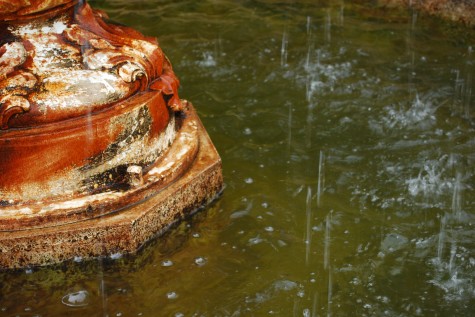
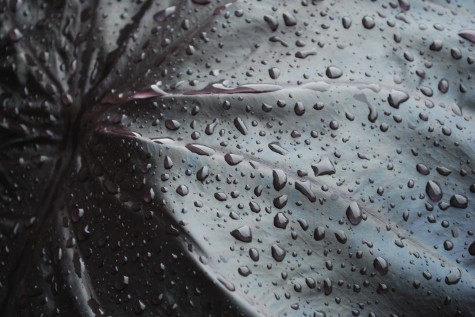
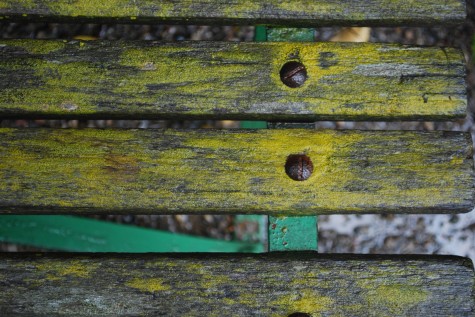

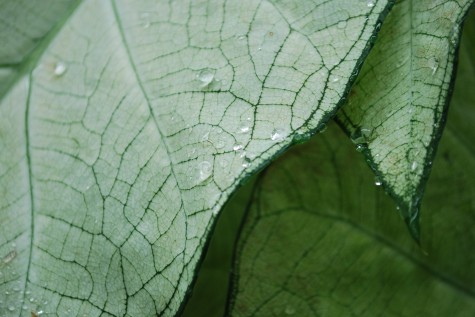
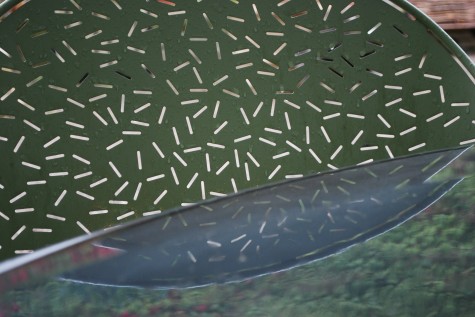
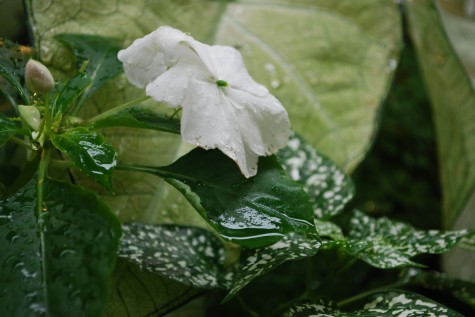


 What could be better than a giant pot stuffed to overflowing with nicotiana? OK, probably plenty of things, but no doubt I am a big fan of the nicotianas. There are a number of ornamental tobaccos suitable for cultivation in our area. The species nicotiana alata pictured above grows strongly to 30″ or better. It has a loose, rangy, and unstructured habit of growth. Sporting clusters of big leaves at the base, the flowers appear all along thin soft stems. They are indeterminate bloomers; a stalk will continue to elongate and produce flowers for months. Once a stalk blooms out, and starts setting seed, I trim it back.
What could be better than a giant pot stuffed to overflowing with nicotiana? OK, probably plenty of things, but no doubt I am a big fan of the nicotianas. There are a number of ornamental tobaccos suitable for cultivation in our area. The species nicotiana alata pictured above grows strongly to 30″ or better. It has a loose, rangy, and unstructured habit of growth. Sporting clusters of big leaves at the base, the flowers appear all along thin soft stems. They are indeterminate bloomers; a stalk will continue to elongate and produce flowers for months. Once a stalk blooms out, and starts setting seed, I trim it back. 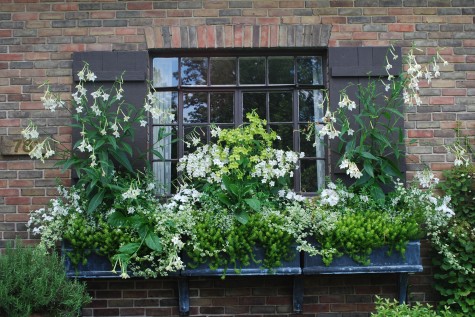

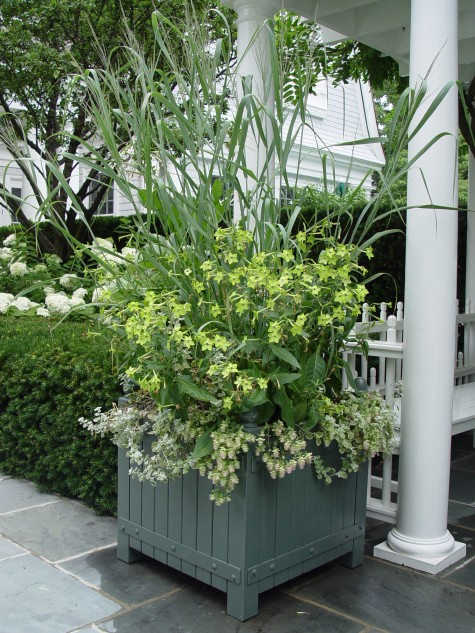 A pairing with Panicum Virgatum Dallas Blues makes that grass all the more icy blue in appearance. Grasses can be difficult to do well in a container, as they are stiff, or awkwardly floppy. Nicotiana makes for a graceful ruff here. They are not without their problems, however. The sticky soft succulent stems are a magnet for aphids. Their giant basil leaves sometimes need pruning back when they threaten to smother something else growing at ground level.
A pairing with Panicum Virgatum Dallas Blues makes that grass all the more icy blue in appearance. Grasses can be difficult to do well in a container, as they are stiff, or awkwardly floppy. Nicotiana makes for a graceful ruff here. They are not without their problems, however. The sticky soft succulent stems are a magnet for aphids. Their giant basil leaves sometimes need pruning back when they threaten to smother something else growing at ground level.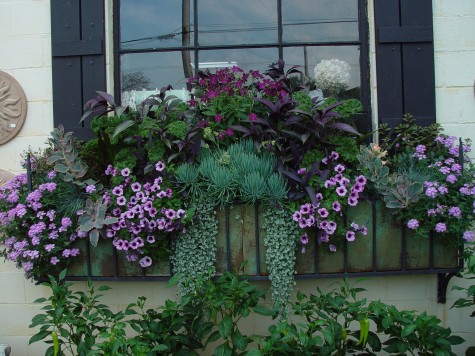
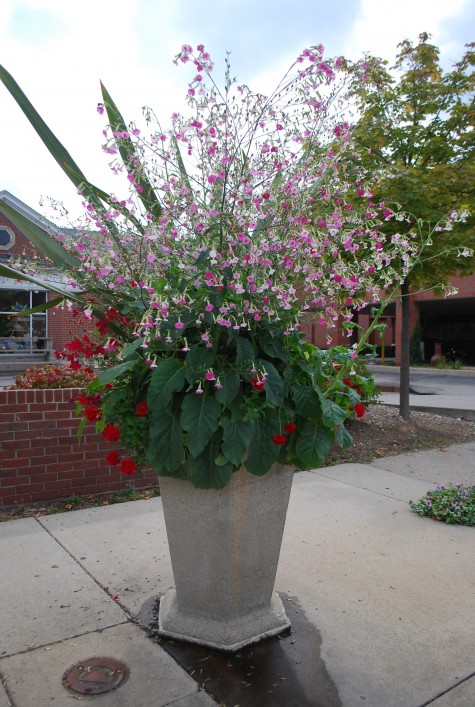 But by far and away my favorite is Nicotiana Mutabilis. It grows tall, and billows out over any edge with a cloud of small flowers that dance in the slightest breeze. Can you tell I like it? The flowers range from white to cream to pale pink to rose pink. This big thing requires secure staking from the beginning. It will pick up speed, and send out new growth from the base of the plant as the night temperatures start to cool.
But by far and away my favorite is Nicotiana Mutabilis. It grows tall, and billows out over any edge with a cloud of small flowers that dance in the slightest breeze. Can you tell I like it? The flowers range from white to cream to pale pink to rose pink. This big thing requires secure staking from the beginning. It will pick up speed, and send out new growth from the base of the plant as the night temperatures start to cool.  They are a nuisance to keep deadheaded-I don’t fuss so much with that. Its hard to spot which stems need headling back, and every part of the plant is sticky. This seems a fairly minor problem to me; a well grow stand of mutabilis is enchanting.
They are a nuisance to keep deadheaded-I don’t fuss so much with that. Its hard to spot which stems need headling back, and every part of the plant is sticky. This seems a fairly minor problem to me; a well grow stand of mutabilis is enchanting.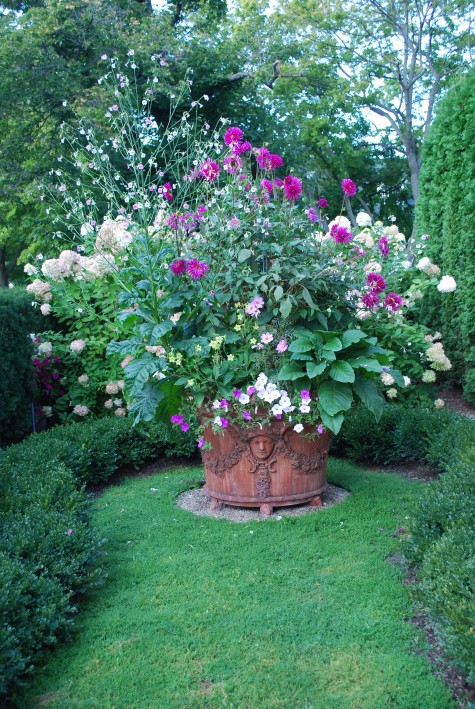 You can see the new growth pushing from the base of this pot on both sides; all of this came on strong in September, and will continue until a hard freeze. They also seem much more aphid-resistant than other nicotianas.
You can see the new growth pushing from the base of this pot on both sides; all of this came on strong in September, and will continue until a hard freeze. They also seem much more aphid-resistant than other nicotianas. The individual flowers are so small and so delicate; the overall picture is delightfully meadow like. All of these nicotianas are a staple of my summer garden.
The individual flowers are so small and so delicate; the overall picture is delightfully meadow like. All of these nicotianas are a staple of my summer garden.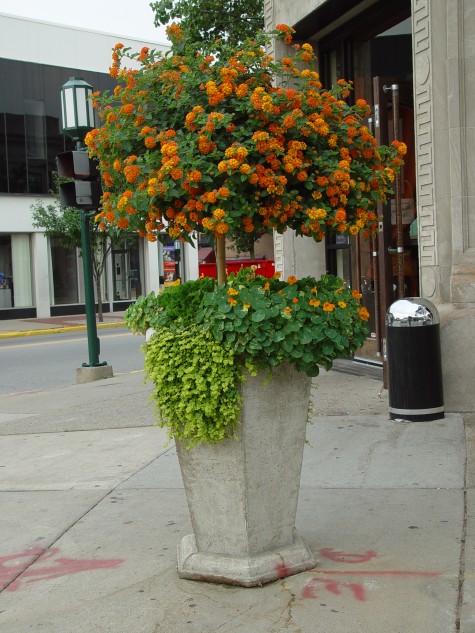 Topiary is the art of pruning, and training a plant to grow in whatever shape you might fancy. Plenty of plant species lend themselves to this kind of treatment. The above pictured lantana is seven years old. It began as a small plant, whose side branches were removed until the primary trunk was about four feet tall. A devoted grower then pinched back the main leader-the first step in the formation of the top. As I like slightly flattened spherical shapes in topiary, we keep the top pruned, and grow the side shoots wide. Lantana flowers profusely in hot weather, it makes a strikingly statuesque topiary plant. In the fall, I cut the head of the plant back by two-thirds,, strip all the remaining leaves off, and stash it in the greenhouse. I strip the leaves off, as lantana is a magnet for whitefly-and they multiply like lightening in a green house environment. What they require is plenty of trouble, but it is glorious in form and flower.
Topiary is the art of pruning, and training a plant to grow in whatever shape you might fancy. Plenty of plant species lend themselves to this kind of treatment. The above pictured lantana is seven years old. It began as a small plant, whose side branches were removed until the primary trunk was about four feet tall. A devoted grower then pinched back the main leader-the first step in the formation of the top. As I like slightly flattened spherical shapes in topiary, we keep the top pruned, and grow the side shoots wide. Lantana flowers profusely in hot weather, it makes a strikingly statuesque topiary plant. In the fall, I cut the head of the plant back by two-thirds,, strip all the remaining leaves off, and stash it in the greenhouse. I strip the leaves off, as lantana is a magnet for whitefly-and they multiply like lightening in a green house environment. What they require is plenty of trouble, but it is glorious in form and flower. 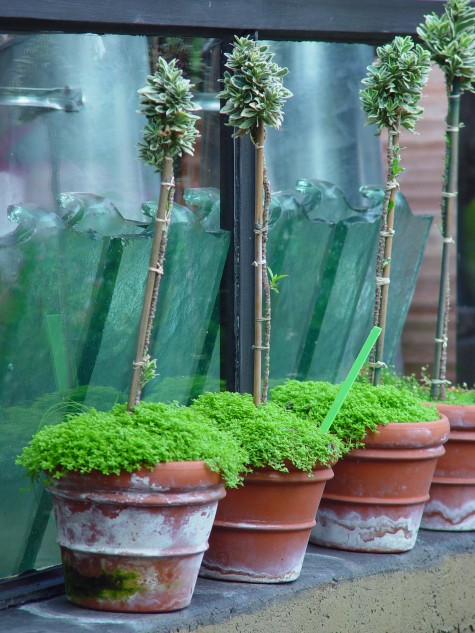 Well grown large topiary plants are expensive. It takes a lot of time to grow them on-sometimes years go by before a plant can be sold. This dwarf variegated euonymus with a batch of leaves atop a stem tells the story. In ten years, this plant will not be much taller-just much stockier, with a full head of leafy branches. As euonymus is a hardy shrub, they like to be wintered in a cool light place.
Well grown large topiary plants are expensive. It takes a lot of time to grow them on-sometimes years go by before a plant can be sold. This dwarf variegated euonymus with a batch of leaves atop a stem tells the story. In ten years, this plant will not be much taller-just much stockier, with a full head of leafy branches. As euonymus is a hardy shrub, they like to be wintered in a cool light place. 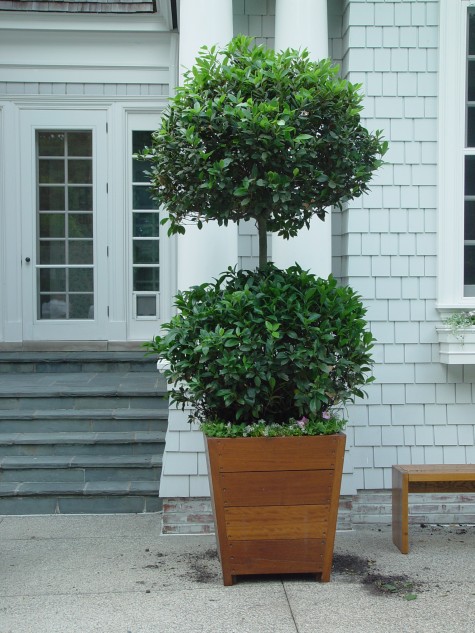 Bay Laurel is not hardy here, unfortunately-so a greenhouse is a necessity in the winter. This plant is 14 years old. This single ball topiary suckered at the base so persistently, I finally just let it grow. The formal shape is easy to keep up; you can see it needs a little haircut right now. There are many kinds of topiary shears available-I like short bladed snips, so I can cut branches without slicing into the leaves. Any leaf that is cut will show that telltale browing on that cut edge within days. �
Bay Laurel is not hardy here, unfortunately-so a greenhouse is a necessity in the winter. This plant is 14 years old. This single ball topiary suckered at the base so persistently, I finally just let it grow. The formal shape is easy to keep up; you can see it needs a little haircut right now. There are many kinds of topiary shears available-I like short bladed snips, so I can cut branches without slicing into the leaves. Any leaf that is cut will show that telltale browing on that cut edge within days. �
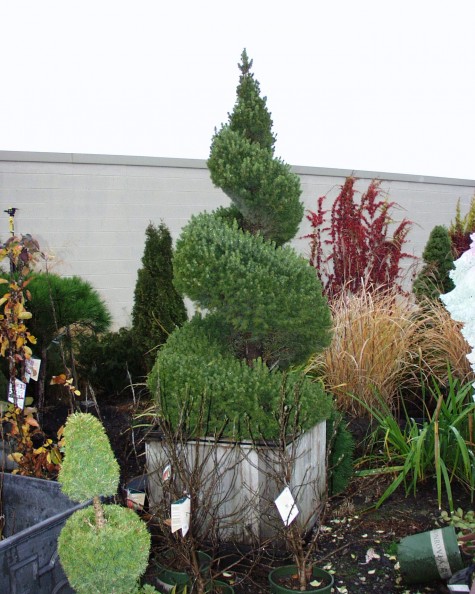

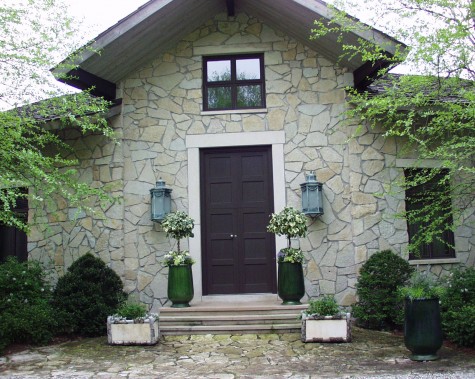 Ivy can be readily be trained over a wire form. This makes it an ideal subject for fast growing. The vines are tied to the form to provide completely coverage, and the vines are clipped as needed. Hedera algeriensis ” Gloire de Marengo”, or variegated Algerian ivy, has large glossy leaves, and a prominent white variegation; old topiaries grown from this plant are striking. A bonus-it is possible to winter ivy topiaries over in the house.
Ivy can be readily be trained over a wire form. This makes it an ideal subject for fast growing. The vines are tied to the form to provide completely coverage, and the vines are clipped as needed. Hedera algeriensis ” Gloire de Marengo”, or variegated Algerian ivy, has large glossy leaves, and a prominent white variegation; old topiaries grown from this plant are striking. A bonus-it is possible to winter ivy topiaries over in the house.  The coleus topiary I let go after two seasons-they seem to loose vigor. The minute you decide to grow a plant in any form which is not its natural form, there will be maintenance problems down the road. Plants tolerate being fooled with by people-they rarely love it. Plants that naturally lend themselves to this treatment are easier to look after.
The coleus topiary I let go after two seasons-they seem to loose vigor. The minute you decide to grow a plant in any form which is not its natural form, there will be maintenance problems down the road. Plants tolerate being fooled with by people-they rarely love it. Plants that naturally lend themselves to this treatment are easier to look after.